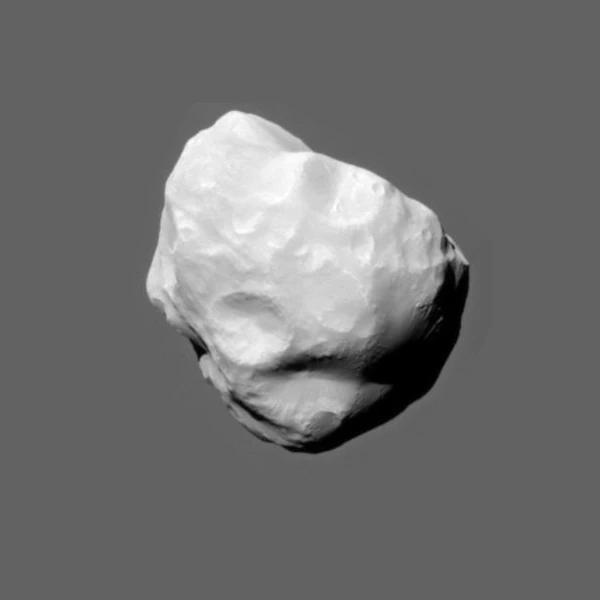
Helene, also known as Saturn XII, is a small moon only 36 kilometers in diameter, discovered in 1980 by Pierre Laques and Jean Lecacheux using observations from the OEA telescope. It occupies a Lagrange point located 60° ahead of Dione on the same orbit, giving it a stable gravitational equilibrium around Saturn.
Helene follows a nearly circular orbit at 377,400 km from Saturn's center and has synchronous rotation, meaning the same face always points toward Dione. Its elongated and irregular shape likely results from gravitational interactions with Saturn and Dione.
Its size and density allow an estimated surface gravity of \(\approx 0.0023\, m/s^2\), extremely low compared to Earth.
Helene is a fascinating example of a co-orbital moon in Saturn's system. It shares almost the same orbit as Dione, about 377,400 km from Saturn's center, but lies 60° ahead of Dione in the orbital plane. This position corresponds to the L4 Lagrange point of the Dione-Saturn system, ensuring remarkable gravitational stability over astronomical timescales.
Its slightly elongated, irregular shape results from the combined gravitational forces of Saturn and Dione, as well as its low surface gravity, estimated at \(\approx 0.0023\, m/s^2\). Helene rotates synchronously, always keeping the same face toward Dione, similar to the Moon-Earth relationship.
The presence of Helene and its opposite Lagrange companion, Polydeuces, perfectly illustrates the dynamics of Lagrange points in a three-body system. These points allow small bodies to remain in stable orbits without colliding with the primary, here Dione.
Detailed observations by the Cassini spacecraft have mapped its surface and analyzed its composition, revealing a mixture of water ice and rocky material similar to Dione. This chemical and gravitational link highlights the importance of co-orbital interactions in the evolution of moon systems around giant planets.
Note:
Lagrange points L4 and L5 are stable positions located 60° ahead and 60° behind a secondary body (here Dione) in its orbit around a primary body (Saturn). Objects captured at these co-orbital points can remain stable for millions of years.
| Moon | Diameter (km) | Distance from Saturn (km) | Particularity |
|---|---|---|---|
| Helene | 36 | 377,400 | Co-orbital with Dione, Lagrange point L4 |
| Polydeuces | 3–4 | 377,400 | Co-orbital with Dione, Lagrange point L5 |
| Telesto | 24 | 294,700 | Co-orbital with Tethys, Lagrange point L4 |
| Calypso | 21 | 294,700 | Co-orbital with Tethys, Lagrange point L5 |
| Janus | 179 | 151,500 | Co-orbital with Epimetheus, swapping orbital positions |
| Epimetheus | 116 | 151,500 | Co-orbital with Janus, swapping orbital positions |
Source: NASA Solar System Exploration – Helene and other co-orbital moons
Helene perfectly illustrates the possible stability in co-orbital systems and remains a fascinating example of small moons maintaining precise gravitational balance through Lagrange points.